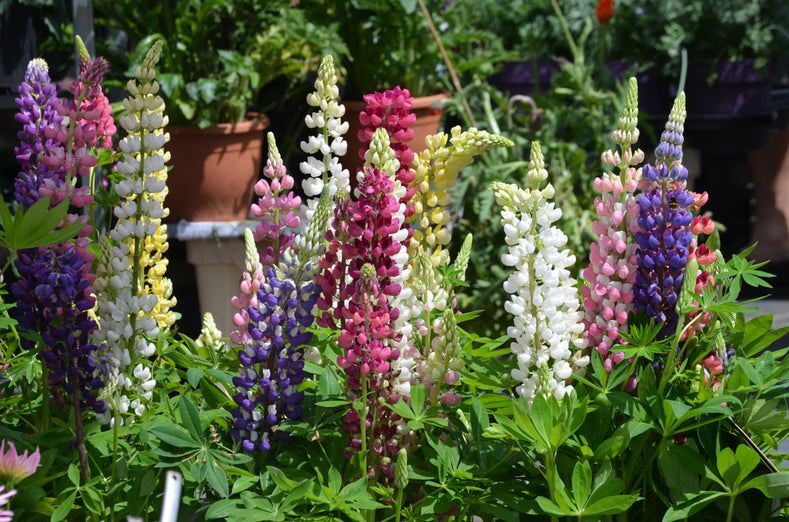Lupins, with their striking and vibrant flower spikes, are quintessential cottage-garden plants. Their captivating beauty extends beyond just cottage gardens; these sun-loving flowers thrive in various settings, making them a versatile addition to formal borders, gravel gardens, containers, and more. Don't hesitate to introduce them to your garden and witness their easy-going nature and captivating allure!
Choose the Right Time for Planting: Lupins are best planted in early spring when the soil is moist and temperatures are mild.
Select a Suitable Location: Lupins thrive in full sunlight, so choose a spot in your garden that receives at least 6-8 hours of direct sunlight each day. The soil should be well-draining, as Lupins prefer moist but not waterlogged conditions.
Prepare the Soil: Before planting, prepare the soil by loosening it to a depth of around 30 cm. Remove any weeds or debris and mix in some organic compost or well-rotted manure to improve the soil's fertility and structure.
Soak the Bare Roots: Prior to planting, soak the Lupin bare roots in a bucket of water for a few hours. This helps to rehydrate the roots and encourages faster establishment.
Planting the Bare Roots: Dig a hole that is deep enough to accommodate the Lupin roots without bending or crowding them. A good rule of thumb is to dig a hole twice the size of the root ball. Place the root in the hole and cover it with soil, gently pressing the soil down around the root to eliminate air pockets.
Spacing: Space Lupin plants at least 30 to 45 cm apart to allow them enough room to grow and spread without overcrowding.
Watering: After planting, give the Lupin bare roots a thorough watering. Keep the soil consistently moist, especially during the first few weeks as the roots establish. Once the plants are well-established, they can tolerate slightly drier conditions.
Mulching: Apply a layer of organic mulch around the base of the Lupin plants to retain soil moisture, suppress weed growth, and regulate the soil temperature. Avoid placing the mulch too close to the plant's stem to prevent rot.
Supporting the Plants: Lupins can grow tall and may need support to prevent them from falling over, particularly in windy areas. Use stakes or a plant support system to keep the plants upright as they grow.
Fertilising: Lupins generally do not require heavy feeding. If your soil is poor, you can apply a balanced, slow-release fertiliser during the growing season. Avoid using high-nitrogen fertilisers, as they can promote excessive foliage growth at the expense of flowers.
Deadheading: Deadhead the faded flowers regularly to encourage the plant to produce more blooms and extend the flowering period.
Pest and Disease Control: Keep an eye out for common garden pests like aphids and slugs. If necessary, use environmentally friendly methods to control them. Lupins can sometimes be susceptible to powdery mildew, so ensure good air circulation around the plants and avoid overhead watering.
Overwintering: In colder climates, Lupins can be cut back to the ground after the first frost. Apply a layer of mulch over the root area to protect the plant during winter.
By following these steps, you can successfully grow Lupin bare roots and enjoy their vibrant blooms in your garden for years to come. Happy gardening!


